Recovery of Carbon Fibers from Carbon Fiber-Reinforced Plastics Using Microwave-Assisted Sulfuric Acid Treatment and Reuse of Recycled Carbon Fibers
Abstract
1. Introduction
2. Materials and Methods
2.1. Materials
2.2. Experimental Process
2.2.1. Recovery of CFRP in Concentrated Sulfuric Acid
2.2.2. Manufacturing of Carbon Fiber-Reinforced Plastics
2.3. Characterization
3. Results and Discussion
3.1. Effect of Reaction Conditions on Resin Degradation
3.2. Carbon Fiber Morphology
3.3. Raman and XRD Analysis
3.4. XPS and FTIR Analysis
3.5. Contact Angle Analysis
3.6. Properties of VCFRP and RCFRP
3.7. Resin Decomposition Products
4. Conclusions
Author Contributions
Funding
Data Availability Statement
Acknowledgments
Conflicts of Interest
References
- Kim, H.-H.; Kim, B.-J. Recovery of Carbon Fibers from Carbon Fiber-Reinforced Epoxy-Isophorone Diamine Composites via Step Thermolysis. Compos. Part B Eng. 2023, 260, 110757. [Google Scholar] [CrossRef]
- Zhang, J.; Lin, G.; Vaidya, U.; Wang, H. Past, Present and Future Prospective of Global Carbon Fibre Composite Developments and Applications. Compos. Part B Eng. 2023, 250, 110463. [Google Scholar] [CrossRef]
- Pickering, S.J. Recycling Technologies for Thermoset Composite Materials—Current Status. Compos. Part A Appl. Sci. Manuf. 2006, 37, 1206–1215. [Google Scholar] [CrossRef]
- Aldosari, S.M.; AlOtaibi, B.M.; Alblalaihid, K.S.; Aldoihi, S.A.; AlOgab, K.A.; Alsaleh, S.S.; Alshamary, D.O.; Alanazi, T.H.; Aldrees, S.D.; Alshammari, B.A. Mechanical Recycling of Carbon Fiber-Reinforced Polymer in a Circular Economy. Polymers 2024, 16, 1363. [Google Scholar] [CrossRef]
- Butenegro, J.A.; Bahrami, M.; Abenojar, J.; Martínez, M.Á. Recent Progress in Carbon Fiber Reinforced Polymers Recycling: A Review of Recycling Methods and Reuse of Carbon Fibers. Materials 2021, 14, 6401. [Google Scholar] [CrossRef]
- García, D.; Vegas, I.; Cacho, I. Mechanical Recycling of GFRP Waste as Short-Fiber Reinforcements in Microconcrete. Constr. Build. Mater. 2014, 64, 293–300. [Google Scholar] [CrossRef]
- Meyer, L.O.; Schulte, K.; Grove-Nielsen, E. CFRP-Recycling Following a Pyrolysis Route: Process Optimization and Potentials. J. Compos. Mater. 2009, 43, 1121–1132. [Google Scholar] [CrossRef]
- Wei, Y.; Hadigheh, S.A. Enhancing Carbon Fibre Recovery through Optimised Thermal Recycling: Kinetic Analysis and Operational Parameter Investigation. Mater. Today Sustain. 2024, 25, 100661. [Google Scholar] [CrossRef]
- Pickering, S.J.; Kelly, R.M.; Kennerley, J.R.; Rudd, C.D.; Fenwick, N.J. A Fluidised-Bed Process for the Recovery of Glass Fibres from Scrap Thermoset Composites. Compos. Sci. Technol. 2000, 60, 509–523. [Google Scholar] [CrossRef]
- Jeong, J.-S.; Kim, K.-W.; An, K.-H.; Kim, B.-J. Fast Recovery Process of Carbon Fibers from Waste Carbon Fibers-Reinforced Thermoset Plastics. J. Environ. Manag. 2019, 247, 816–821. [Google Scholar] [CrossRef]
- Piñero-Hernanz, R.; Dodds, C.; Hyde, J.; García-Serna, J.; Poliakoff, M.; Lester, E.; Cocero, M.J.; Kingman, S.; Pickering, S.; Wong, K.H. Chemical Recycling of Carbon Fibre Reinforced Composites in Nearcritical and Supercritical Water. Compos. Part A Appl. Sci. Manuf. 2008, 39, 454–461. [Google Scholar] [CrossRef]
- Jiang, G.; Pickering, S.J.; Lester, E.H.; Turner, T.A.; Wong, K.H.; Warrior, N.A. Characterisation of Carbon Fibres Recycled from Carbon Fibre/Epoxy Resin Composites Using Supercritical n-Propanol. Compos. Sci. Technol. 2009, 69, 192–198. [Google Scholar] [CrossRef]
- Hanaoka, T.; Ikematsu, H.; Takahashi, S.; Ito, N.; Ijuin, N.; Kawada, H.; Arao, Y.; Kubouchi, M. Recovery of Carbon Fiber from Prepreg Using Nitric Acid and Evaluation of Recycled CFRP. Compos. Part B Eng. 2022, 231, 109560. [Google Scholar] [CrossRef]
- Jiang, J.; Deng, G.; Chen, X.; Gao, X.; Guo, Q.; Xu, C.; Zhou, L. On the Successful Chemical Recycling of Carbon Fiber/Epoxy Resin Composites under the Mild Condition. Compos. Sci. Technol. 2017, 151, 243–251. [Google Scholar] [CrossRef]
- Rijo, B.; Dias, A.P.S.; Carvalho, J.P.S. Recovery of Carbon Fibers from Aviation Epoxy Composites by Acid Solvolysis. Sustain. Mater. Technol. 2023, 35, e00545. [Google Scholar] [CrossRef]
- Kubouchi, M.; Tsuda, K.; Nishiyama, T.; Hojo, H. A Study on an Application of Corrosion Behavior to Glass Fiber Composite Disposal and Recycling. Adv. Compos. Lett. 1995, 4, 13–15. [Google Scholar] [CrossRef]
- Hanaoka, T.; Arao, Y.; Kayaki, Y.; Kuwata, S.; Kubouchi, M. Analysis of Nitric Acid Decomposition of Epoxy Resin Network Structures for Chemical Recycling. Polym. Degrad. Stab. 2021, 186, 109537. [Google Scholar] [CrossRef]
- Dang, W.; Kubouchi, M.; Sembokuya, H.; Tsuda, K. Chemical Recycling of Glass Fiber Reinforced Epoxy Resin Cured with Amine Using Nitric Acid. Polymer 2005, 46, 1905–1912. [Google Scholar] [CrossRef]
- Dang, W.; Kubouchi, M.; Yamamoto, S.; Sembokuya, H.; Tsuda, K. An Approach to Chemical Recycling of Epoxy Resin Cured with Amine Using Nitric Acid. Polymer 2002, 43, 2953–2958. [Google Scholar] [CrossRef]
- Lee, S.-H.; Choi, H.-O.; Kim, J.-S.; Lee, C.-K.; Kim, Y.-K.; Ju, C.-S. Circulating Flow Reactor for Recycling of Carbon Fiber from Carbon Fiber Reinforced Epoxy Composite. Korean J. Chem. Eng. 2011, 28, 449–454. [Google Scholar] [CrossRef]
- Deng, J.; Xu, L.; Zhang, L.; Peng, J.; Guo, S.; Liu, J.; Koppala, S. Recycling of Carbon Fibers from CFRP Waste by Microwave Thermolysis. Processes 2019, 7, 207. [Google Scholar] [CrossRef]
- Salas, A.; Berrio, M.E.; Martel, S.; Díaz-Gómez, A.; Palacio, D.A.; Tuninetti, V.; Medina, C.; Meléndrez, M.F. Towards Recycling of Waste Carbon Fiber: Strength, Morphology and Structural Features of Recovered Carbon Fibers. Waste Manag. 2023, 165, 59–69. [Google Scholar] [CrossRef] [PubMed]
- Zhao, Q.; Jiang, J.; Zhang, L.; Wang, S.; Chen, J.; Yao, X.; Li, Y. Simple and Mild Method for the Recycling of Carbon-Fiber-Reinforced Bismaleimide Resin Composite Waste. ACS Sustain. Chem. Eng. 2023, 11, 2830–2839. [Google Scholar] [CrossRef]
- Wu, T.; Zhan, W.; Jia, X.; Li, H.; Sui, G.; Yang, X. Solvent-Free Rapid Degradation of Epoxy Composites and Recycling Application of High Performance Carbon Fibers through the Synergic Catalysis Effect of Molten Salts and Titanium Dioxide. Polym. Degrad. Stab. 2022, 196, 109849. [Google Scholar] [CrossRef]
- Pan, Y.; Mao, J.; Ding, J. Effect of Carbon Fiber Surface Modification on the Mechanical Properties of Carbon-Fiber-Reinforced Ultrahigh-Molecular-Weight Polyethylene Composite. J. Mater. Eng. Perform. 2019, 28, 1995–2005. [Google Scholar] [CrossRef]
- Huson, M.G.; Church, J.S.; Kafi, A.A.; Woodhead, A.L.; Khoo, J.; Kiran, M.S.R.N.; Bradby, J.E.; Fox, B.L. Heterogeneity of Carbon Fibre. Carbon 2014, 68, 240–249. [Google Scholar] [CrossRef]
- Wang, X.; Qian, X.; Zhang, Y.; Wang, X.; Song, S.; Zhang, C. Surface Oxidation of PAN-Based Ultrahigh Modulus Carbon Fibers (UHMCFs) and Its Effect on the Properties of UHMCF/EP Composites. Carbon Lett. 2021, 31, 449–461. [Google Scholar] [CrossRef]
- Liu, F.; Wang, H.; Xue, L.; Fan, L.; Zhu, Z. Effect of Microstructure on the Mechanical Properties of PAN-Based Carbon Fibers during High-Temperature Graphitization. J. Mater. Sci. 2008, 43, 4316–4322. [Google Scholar] [CrossRef]
- Xu, P.; Li, J.; Ding, J. Chemical Recycling of Carbon Fibre/Epoxy Composites in a Mixed Solution of Peroxide Hydrogen and N,N-Dimethylformamide. Compos. Sci. Technol. 2013, 82, 54–59. [Google Scholar] [CrossRef]
- Wu, T.; Zhang, W.; Jin, X.; Liang, X.; Sui, G.; Yang, X. Efficient Reclamation of Carbon Fibers from Epoxy Composite Waste through Catalytic Pyrolysis in Molten ZnCl2. RSC Adv. 2018, 9, 377–388. [Google Scholar] [CrossRef]
- Guo, H.; Huang, Y.D.; Meng, L.H.; Liu, L.; Fan, D.P.; Liu, D.X. Interface Property of Carbon Fibers/Epoxy Resin Composite Improved by Hydrogen Peroxide in Supercritical Water. Mater. Lett. 2009, 63, 1531–1534. [Google Scholar] [CrossRef]
- Huang, H.; Yin, Y.; Cheng, H.; Zhao, Z.; Zhang, B. Degradation Mechanism of CF/EP Composites in Supercritical n-Butanol with Alkali Additives. J Polym. Environ. 2017, 25, 115–125. [Google Scholar] [CrossRef]
- Ma, L.; Li, N.; Wu, G.; Song, G.; Li, X.; Han, P.; Wang, G.; Huang, Y. Interfacial Enhancement of Carbon Fiber Composites by Growing TiO2 Nanowires onto Amine-Based Functionalized Carbon Fiber Surface in Supercritical Water. Appl. Surf. Sci. 2018, 433, 560–567. [Google Scholar] [CrossRef]
- Tian, H.; Yao, Y.; Liu, D.; Li, Y.; Jv, R.; Xiang, G.; Xiang, A. Enhanced Interfacial Adhesion and Properties of Polypropylene/Carbon Fiber Composites by Fiber Surface Oxidation in Presence of a Compatibilizer. Polym. Compos. 2019, 40, E654–E662. [Google Scholar] [CrossRef]
- Ansari, M.S.; Zafar, S.; Pathak, H. A Comprehensive Review of Surface Modification Techniques for Carbon Fibers for Enhanced Performance of Resulting Composites. Results Surf. Interfaces 2023, 12, 100141. [Google Scholar] [CrossRef]
- Mozes, M.S. Volume Reduction of Spent Ion-Exchange Resin by Acid Digestion. Nucl. Technol. 1982, 59, 270–278. [Google Scholar] [CrossRef]
- Shen, M.; Robertson, M.L. Degradation Behavior of Biobased Epoxy Resins in Mild Acidic Media. ACS Sustain. Chem. Eng. 2021, 9, 438–447. [Google Scholar] [CrossRef]
- Savou, V.; Grause, G.; Kumagai, S.; Saito, Y.; Kameda, T.; Yoshioka, T. Pyrolysis of Sugarcane Bagasse Pretreated with Sulfuric Acid. J. Energy Inst. 2019, 92, 1149–1157. [Google Scholar] [CrossRef]
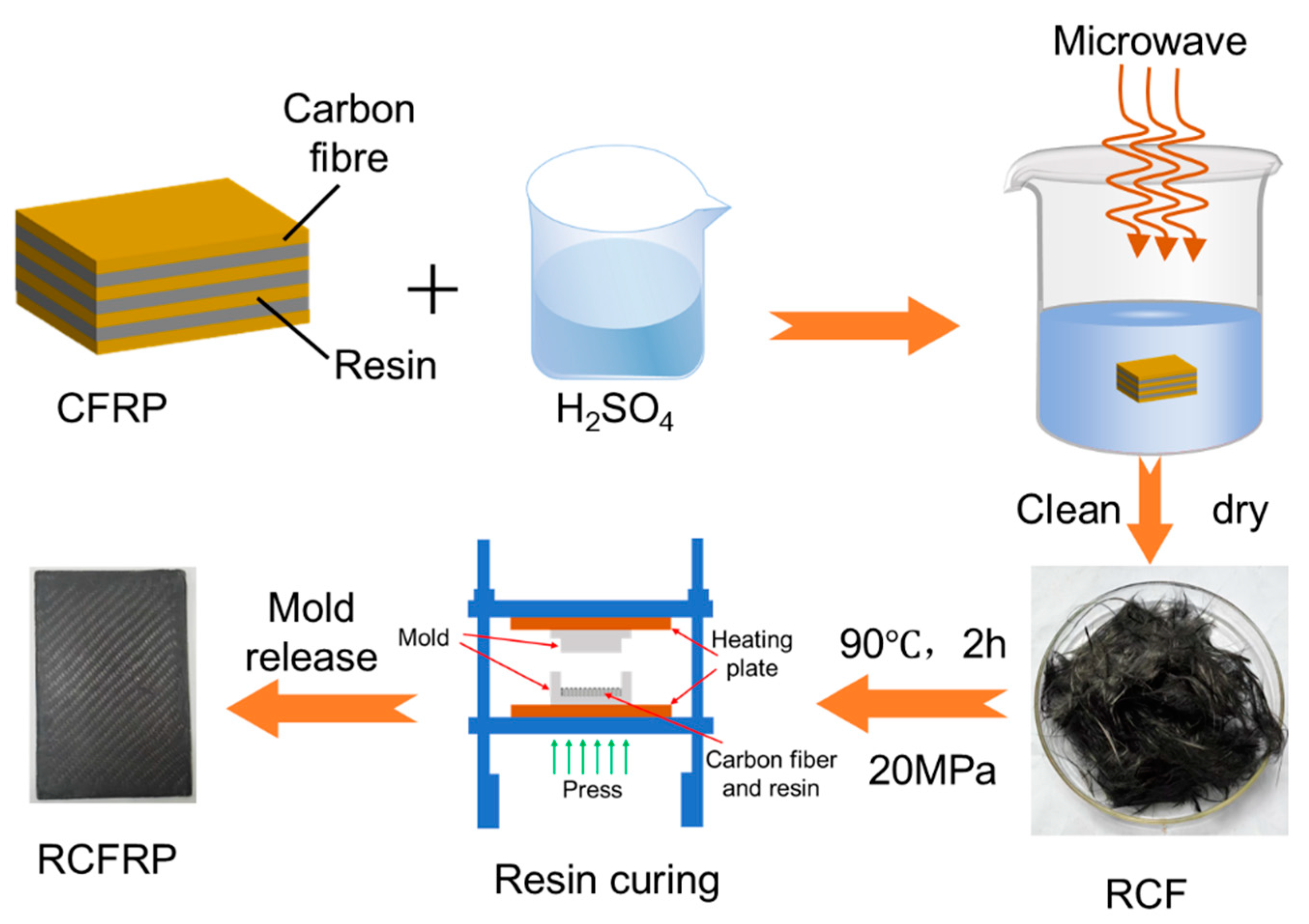
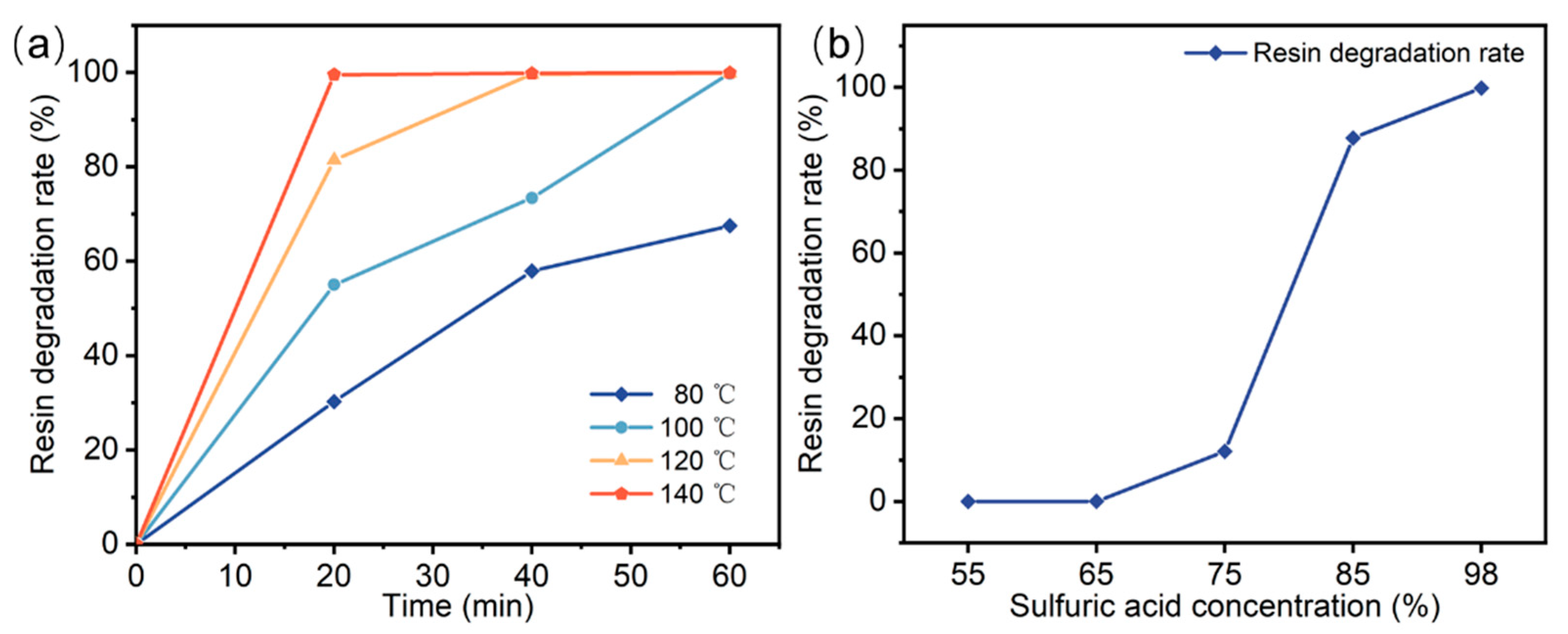

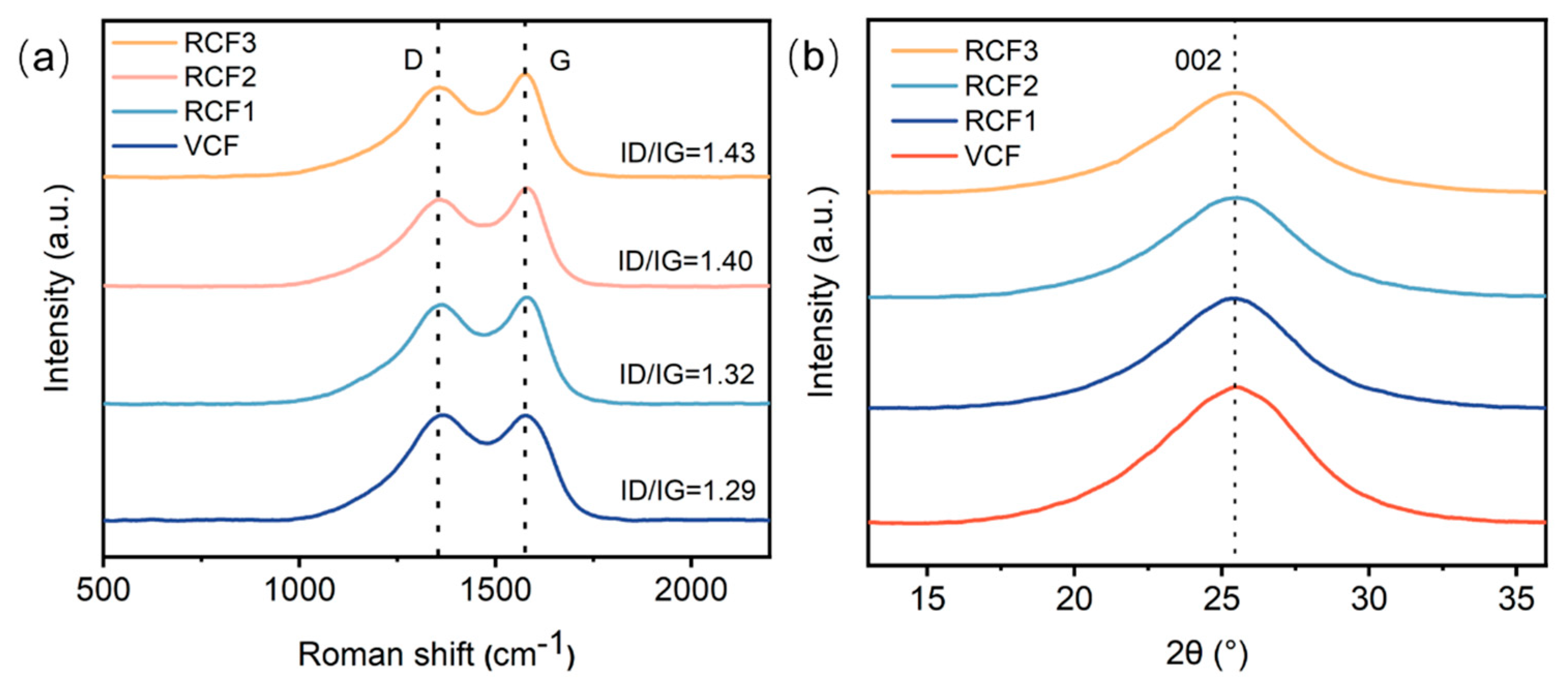

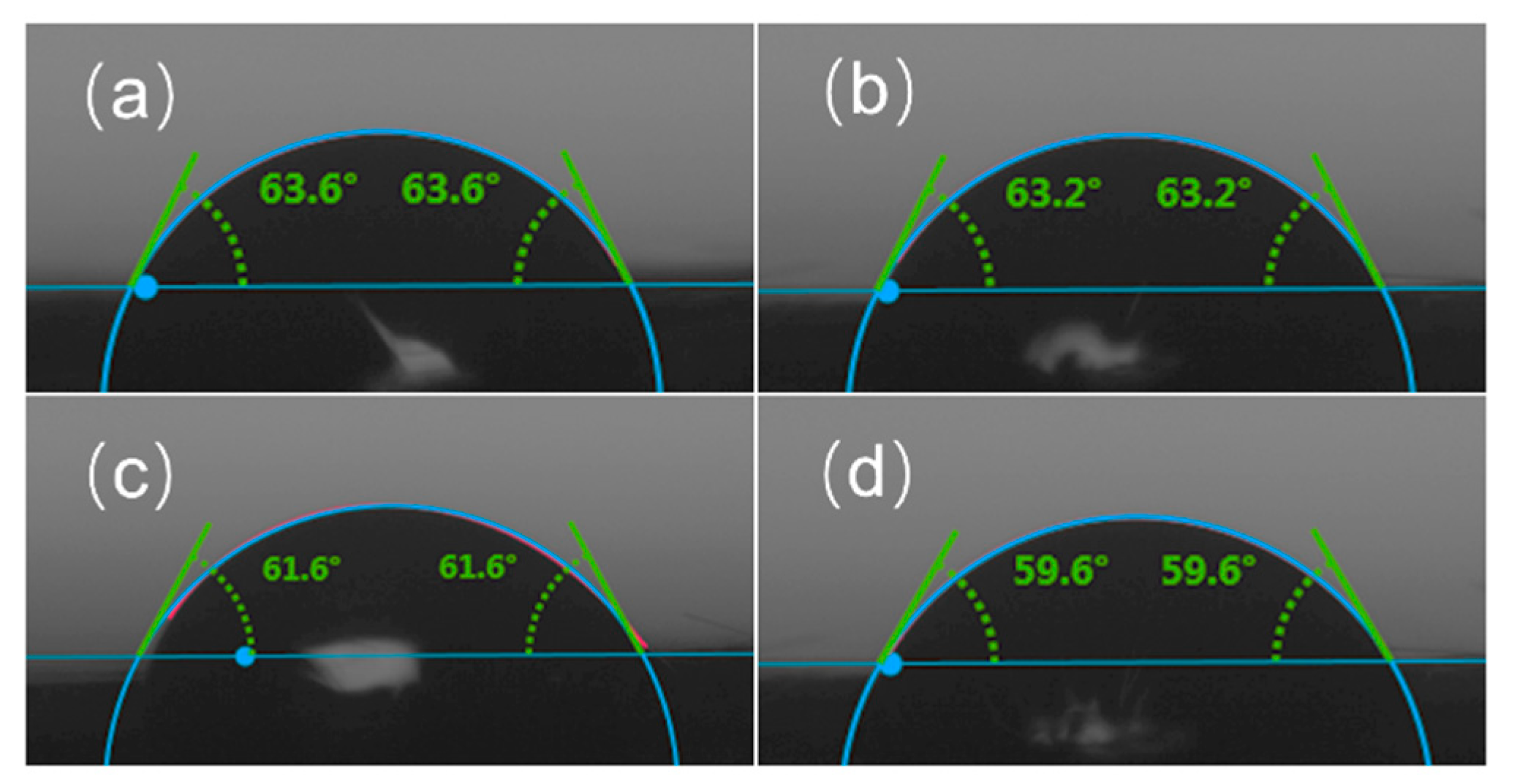
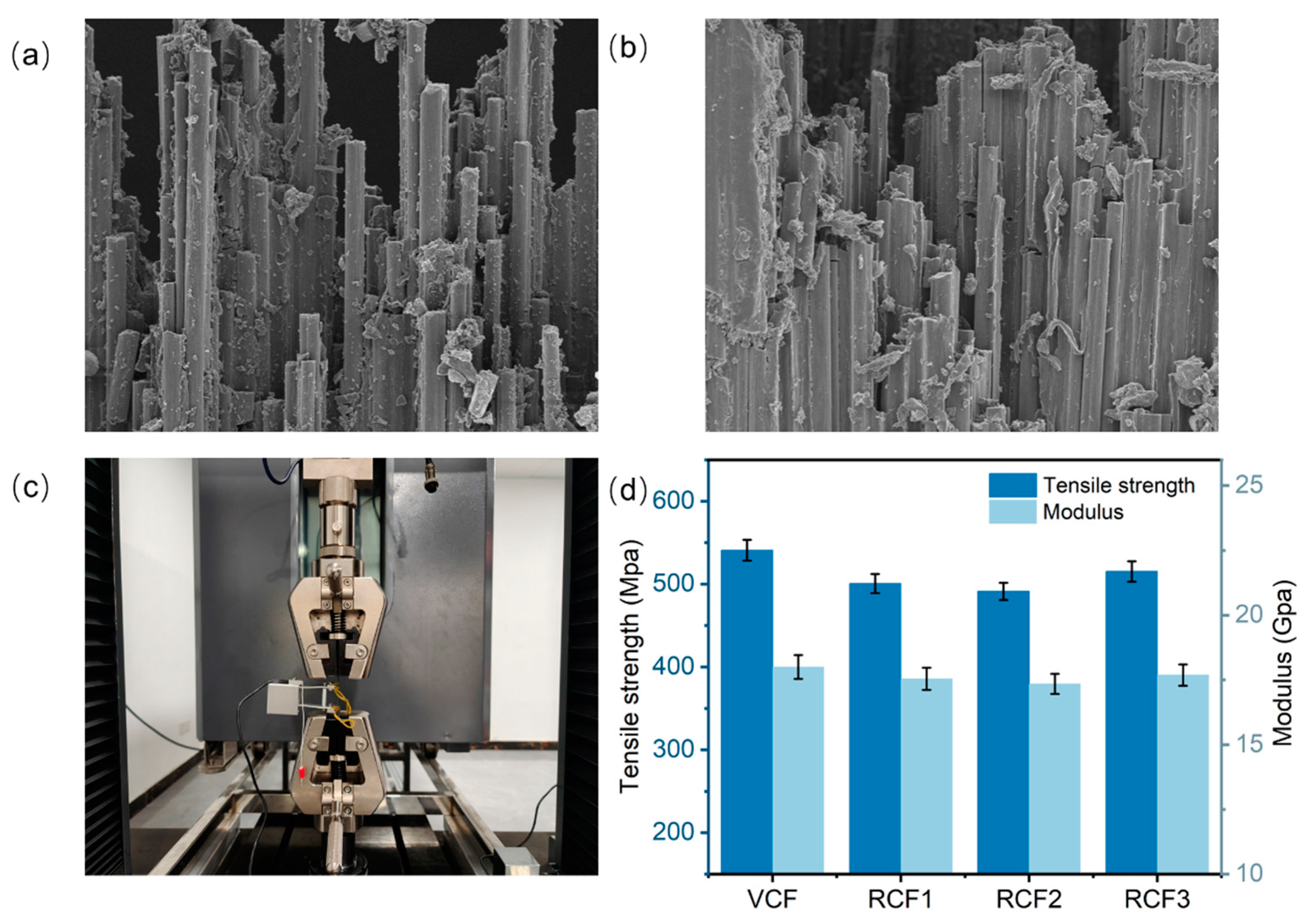
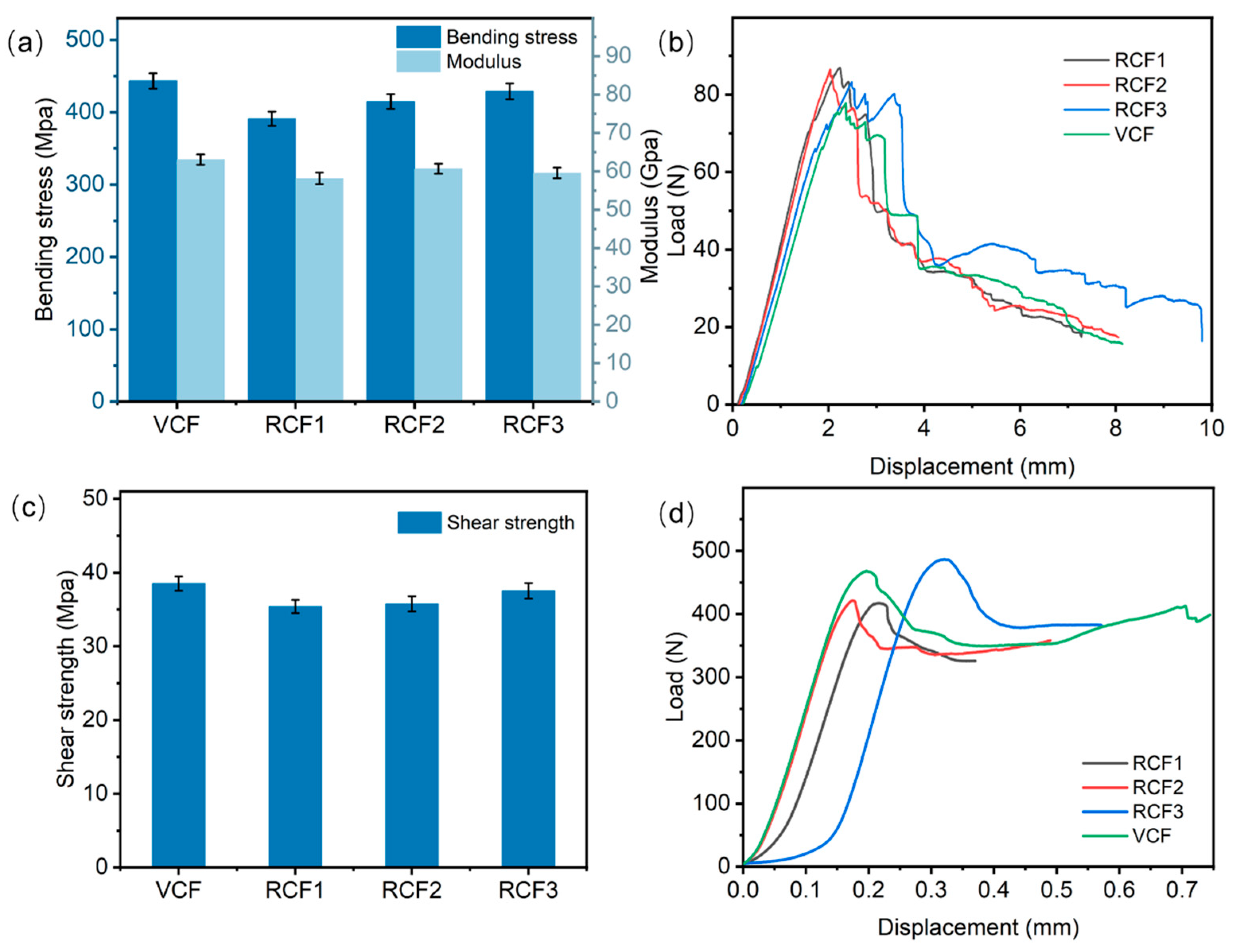

| Reaction Media/Catalyst | Step One | Step Two | |
|---|---|---|---|
| This study | H2SO4 | 100–120 °C, 20–60 min | - |
| Jiang et al. [14] | Macrogol 400, KOH | 160 °C, 200 min | - |
| Zhao et al. [23] | MEA | 160 °C, 300 min | - |
| Kim et al. [1] | Steam | 450 °C, 60 min | 550 °C, 10–90 min |
| Wu et al. [24] | KCl/ZnCl2 | 350 °C, 90 min | 500 °C, 10 min |
| 2θ (deg) | β (rad) | d002 (nm) | Lc (nm) | |
|---|---|---|---|---|
| VCF | 25.193 | 0.088 | 0.353 | 1.590 |
| RCF1 | 25.307 | 0.089 | 0.352 | 1.584 |
| RCF2 | 25.202 | 0.090 | 0.353 | 1.569 |
| RCF3 | 25.217 | 0.093 | 0.353 | 1.503 |
| C | O | N | O/C | C–C | C-O-C | O-C=O | |
|---|---|---|---|---|---|---|---|
| RCF1 | 84.42 | 15.00 | 0.58 | 0.178 | 83.07 | 6.57 | 10.36 |
| RCF2 | 83.3 | 16.17 | 0.53 | 0.194 | 81.83 | 7.76 | 10.41 |
| RCF3 | 83.34 | 16.25 | 0.41 | 0.195 | 76.6 | 7.94 | 15.46 |
| VCF | 83.28 | 16.39 | 0.33 | 0.197 | 83.45 | 7.98 | 8.57 |
| Number | Name | Molecular Formula | Content |
|---|---|---|---|
| 1 | Phenol | C6H6O | 46.21 |
| 2 | p-Cumenol | C9H12O | 29.40 |
| 3 | Benzene, 2-ethyl-1,4-dimethyl- | C10H14 | 9.02 |
| 4 | Benzofuran, 2-methyl- | C9H8O | 5.08 |
| 5 | Benzofuran, 2,3-dihydro-2-methyl- | C9H10O | 3.96 |
| 6 | 2H-1-Benzopyran, 3,4-dihydro- | C9H10O | 2.72 |
| 7 | 2H-1-Benzopyran-3-ol, 3,4-dihydro- | C9H10O2 | 2.05 |
| 8 | Phenol, 4-ethyl- | C8H10O | 1.56 |
Disclaimer/Publisher’s Note: The statements, opinions and data contained in all publications are solely those of the individual author(s) and contributor(s) and not of MDPI and/or the editor(s). MDPI and/or the editor(s) disclaim responsibility for any injury to people or property resulting from any ideas, methods, instructions or products referred to in the content. |
© 2025 by the authors. Licensee MDPI, Basel, Switzerland. This article is an open access article distributed under the terms and conditions of the Creative Commons Attribution (CC BY) license (https://creativecommons.org/licenses/by/4.0/).
Share and Cite
Nan, Z.; Xu, L.; Ren, Y.; Lu, J.; Sun, Y.; Zhang, D.; He, J. Recovery of Carbon Fibers from Carbon Fiber-Reinforced Plastics Using Microwave-Assisted Sulfuric Acid Treatment and Reuse of Recycled Carbon Fibers. Processes 2025, 13, 1437. https://doi.org/10.3390/pr13051437
Nan Z, Xu L, Ren Y, Lu J, Sun Y, Zhang D, He J. Recovery of Carbon Fibers from Carbon Fiber-Reinforced Plastics Using Microwave-Assisted Sulfuric Acid Treatment and Reuse of Recycled Carbon Fibers. Processes. 2025; 13(5):1437. https://doi.org/10.3390/pr13051437
Chicago/Turabian StyleNan, Zheng, Lei Xu, Yiyao Ren, Junyu Lu, Yongfen Sun, Di Zhang, and Jiayu He. 2025. "Recovery of Carbon Fibers from Carbon Fiber-Reinforced Plastics Using Microwave-Assisted Sulfuric Acid Treatment and Reuse of Recycled Carbon Fibers" Processes 13, no. 5: 1437. https://doi.org/10.3390/pr13051437
APA StyleNan, Z., Xu, L., Ren, Y., Lu, J., Sun, Y., Zhang, D., & He, J. (2025). Recovery of Carbon Fibers from Carbon Fiber-Reinforced Plastics Using Microwave-Assisted Sulfuric Acid Treatment and Reuse of Recycled Carbon Fibers. Processes, 13(5), 1437. https://doi.org/10.3390/pr13051437





